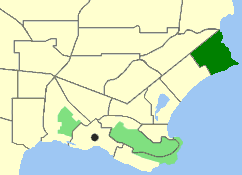
King George Sound is the name of a sound on the south coast of Western Australia. Originally named King George the Third's Sound, it was referred to as King George's Sound from 1805. The name "King George Sound" gradually came into use from about 1934, prompted by new Admiralty charts supporting the intention to eliminate the possessive 's' from geographical names.

The Port of Newcastle is a major seaport in the city of Newcastle, New South Wales Australia. It is the world's largest coal port.
Over 1400 ships have been wrecked on the coast of Western Australia. This relatively large number of shipwrecks is due to a number of factors, including:

Bayonet Head is an outer north-eastern suburb of Albany, Western Australia, on the west bank of Oyster Harbour. Its local government area is the City of Albany. Until the 1980s, it was known as Flinders Park.

Collingwood Park is a north-eastern suburb of Albany, Western Australia, just west of the Emu Point holiday resort along King George Sound on the west bank of Oyster Harbour. Its local government area is the City of Albany.

Green Island is an island in Oyster Harbour located approximately 6.5 kilometres (4 mi) northeast of Albany in Western Australia.

Fremantle Harbour is Western Australia's largest and busiest general cargo port and an important historical site. The inner harbour handles a large volume of sea containers, vehicle imports and livestock exports, cruise shipping and naval visits, and operates 24 hours a day. It is located adjacent to the city of Fremantle, in the Perth metropolitan region.

Oyster Harbour is a permanently open estuary, north of King George Sound, which covers an area of 15.6 square kilometres (6 sq mi) near Albany, Western Australia. The harbour is used to shelter a fishing fleet carrying out commercial fishing and the farming of oysters and mussels via a dredged channel around Emu Point to the Emu Point Boat Pens. A significant number of waterbirds use the harbour for feeding. The place is currently a family tourist center. Oyster Harbour is fed by the King and Kalgan Rivers and discharges into King George Sound.

Lady Elizabeth was a British ship built in 1869 by Robert Thompson Jr. of Sunderland. Robert Thompson Jr. was one of the sons of Robert Thompson Sr. who owned and operated the family ran shipyard J. L. Thompson & Sons. Thompson Jr. eventually left the family business in 1854 to start his own shipbuilding business in Southwick, Sunderland. She was 658 tons and was classified as a barque cargo sailing ship with one deck and three masts. She had a keel and outer planking made from American rock elm and a fore end made from English elm. The stem was made of teak and English oak with an iron floor as the deck. The ship also had copper and iron fastings. The ships was also registered in London under the name Wilson & Co. Messrs Wilson & Co. was based out of Sydney, Australia. The ship carried a comparative classification under American Lloyd's as "First class-third grade"

The Fitzroy was a steel-hulled steamship built in 1912 at Old Kilpatrick, Scotland in 1912. Thirty-one people were killed when Fitzroy capsized in a gale whilst carrying a general cargo between Coffs Harbour and Sydney off Cape Hawke, New South Wales on 26 June 1921.

Emu Point is a north-eastern suburb of Albany in southern Western Australia north-east of Albany's central business district. Its local government area is the City of Albany.
Balls Head Bay, formerly known as Oyster Bay, Wollstonecraft Bay,Sugarworks Bay, Powder Works Bay and Kerosene Bay, is a bay located to the west of the Waverton Peninsula, west of Balls Head and to the east of Berry Island, on the north of Sydney Harbour, Sydney, New South Wales, Australia.

The Albany Fish Traps, also known as the Oyster Harbour Fish Traps, are a series of fish traps situated in Oyster Harbour near the mouth of the Kalgan River approximately 14 kilometres (9 mi) east of Albany in the Great Southern region of Western Australia.
The Arpenteur was a brig owned by William Owen and John Ridley. It was wrecked at Hassell Beach in Cheyne Bay near Cape Riche when a gale ran it ashore 7 November 1849.
Wave was a brig that was wrecked in 1848 at Cheynes Beach near Cape Riche, Western Australia.
34°30′43.8″S138°03′48.4″EZanoni was a ship built in Liverpool, England in 1865 by W. H. Potter & Co as a 338-ton composite barque. It was owned by Thomas Royden & Sons who intended to use it for the East India trade.

Larkins made ten voyages for the British East India Company (EIC), all as an "extra ship", i.e. under contract. On two of these voyages she first transported convicts to Australia. She also made one convict voyage independently of the EIC. She traded extensively between England and India or China, and in this twice suffered serious but not fatal maritime mishaps. In 1853 she became a coal hulk at Albany, Western Australia, and remained there until she was broken up in 1876.

The Newcastle was a clipper ship of the Green Blackwell line that operated on routes from England to India and Australia in the late 19th century. Built in 1857 in Sunderland, England, she was wrecked near the northern tip of Queensland, Australia, in 1883.
Bombay was launched in 1801 at Daman/Demaun. Her early career is obscure. From 1821 on she assumed Calcutta registry. Between 1832 and 1840 she made three voyages from London as a whaler. In 1842 she carried settlers for the New Zealand Company. She was last listed in 1853.












